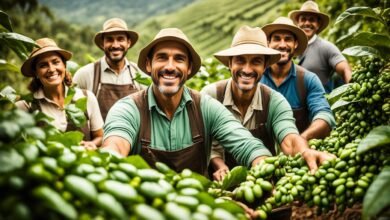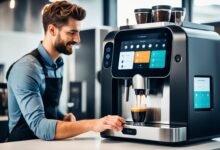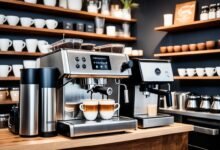Best Coffee Brewing Methods: Elevate Your Cup

Do you remember when a simple cup of coffee was enough to start our mornings? Now, our taste buds have grown, and we’ve found more to enjoy beyond the basic drip machine. From the rich, velvety crema of espresso to the clean, bright flavors of pour-over, coffee has opened a new world of tastes.
In this article, we’ll explore eight easy, affordable, and tasty ways to improve your daily coffee. Whether you love coffee or are just starting to enjoy specialty brews, these methods will help you bring out the best in your favorite beans. They’ll make your coffee at home even better.
Key Takeaways
- Discover eight easy, affordable, and delicious coffee brewing methods to elevate your daily cup
- Learn how to grind your beans fresh for maximum flavor
- Master the optimal water temperature for different brewing techniques
- Understand the importance of getting the coffee-to-water ratio right
- Explore the world of specialty coffee beans and how to choose the best ones
- Enhance your coffee’s flavor with simple additions like syrups or spices
- Dive into the world of brewing equipment and find the right tools for your needs
The Art of Brewing Delicious Coffee
Making the perfect cup of coffee is more than just heating up a drink. It involves picking the best coffee beans and learning how to brew them. Each step affects the coffee experience. Coffee lovers know how crucial these factors are for a great coffee cup.
Key Takeaways
We’ll look at the key elements that make your coffee brewing techniques better. We’ll talk about the importance of water temperature, grind consistency, and the right brewing ratio. These factors ensure your coffee tastes great every time. We’ll also cover how coffee equipment can improve your coffee experience.
| Brewing Method | Extraction Time | Flavor Profile |
|---|---|---|
| Pour-Over | Fewer than 3 minutes | Bright, clean, and balanced |
| French Press | 4-5 minutes | Full-bodied, rich, and complex |
| AeroPress | Around 1 minute | Smooth, sweet, and nuanced |
| Cold Brew | 8-12 hours | Smooth, low-acidity, and naturally sweet |
Learning about coffee brewing will help you make a wonderful coffee experience. You’ll want more of it. Let’s get started and improve your coffee skills!
Grind Your Beans Fresh
Freshly grinding your coffee beans is key to a great cup of coffee. Whole beans stay fresh for 1-2 weeks, but ground coffee loses flavor quickly. To enjoy the best taste, grind just enough for a day or two.
Blade grinders often produce uneven grounds, which can make your coffee taste bad. We recommend a high-quality burr coffee grinder instead. These grinders don’t get too hot and make consistent grounds, so your coffee tastes better.

Grind your fresh ground coffee right before you brew for the best taste. This simple step makes your coffee experience better, letting you enjoy the full taste of your beans.
“Freshly ground coffee ensures you never have to drink stale coffee again, maintaining freshness, vibrancy, and flavor.”
Master the Water Temperature
The water temperature is key to brewing the perfect cup of coffee. Coffee is mostly water, so the quality and temperature of it affect the taste a lot.
The best temperature for making coffee is between 195°F and 205°F. If the water is too cold, the coffee tastes sour and flat. If it’s too hot, the coffee tastes bitter and bad.
For a great cup of coffee, use fresh, filtered water instead of tap water. Tap water can have stuff in it that makes coffee taste bad. Using good water temperature for coffee brings out the best in your coffee beans.
Remember, the best temperature can change depending on how you make your coffee and the beans you use. Trying different water quality for coffee temperatures can help you find what you like best.
| Brewing Method | Ideal Water Temperature Range |
|---|---|
| Drip Coffee | 195°F to 205°F (90°C to 96°C) |
| French Press | 195°F to 205°F (90°C to 96°C) |
| Pour-Over | 195°F to 205°F (90°C to 96°C) |
| Cold Brew | 35°F to 70°F (2°C to 21°C) |
Mastering the water temperature for coffee and using top-notch water quality for coffee helps you make the perfect cup every time.

Optimize the Coffee-to-Water Ratio
Finding the perfect coffee-to-water ratio is key to a great cup of coffee. The right ratio changes with the brewing method. Generally, use two tablespoons of coffee for every six ounces of water, making about one cup. But, it’s important to try different ratios to find what you like best.
Optimal Ratios for Brewing Methods
Each brewing method needs a specific coffee-to-water ratio for the best flavor:
- Pour-over/Drip Coffee: 1 part coffee to 16 parts water (e.g., 1 tablespoon coffee to 6 ounces water)
- French Press: 1 part coffee to 15-16 parts water (e.g., 2 tablespoons coffee to 30 ounces water)
- Espresso: 1 part coffee to 2 parts water (e.g., 1 tablespoon coffee to 2 ounces water)
- Cold Brew: 1 part coffee to 8-10 parts water (e.g., 1/2 cup coffee to 4 cups water)
Too much coffee or water makes your coffee bitter. Too little of either makes it weak. Try different ratios to find what you like best with your brewing method.
| Brewing Method | Coffee-to-Water Ratio |
|---|---|
| Pour-over/Drip | 1:16 |
| French Press | 1:15-16 |
| Espresso | 1:2 |
| Cold Brew | 1:8-10 |
By trying different coffee-to-water ratios, you can find the best one for your taste and brewing method.

“The Golden Ratio for coffee brewing is around 1 gram of coffee to 15-18 grams of water, with slight variations such as 1:16 highlighting floral notes and 1:14 accentuating bold flavors.”
Best Coffee Brewing Methods
Brewing coffee is an art form with many methods to try. Whether you like a strong, full-bodied coffee or a light, delicate pour-over, there’s a method for you. Let’s explore some top coffee brewing methods and what makes them special.
Pour Over
The pour-over method is popular for its clean, nuanced coffee. It lets you control the water temperature and flow. This results in a coffee that’s aromatic and delicate.
French Press
The French press is great for those who want a strong coffee. You steep the grounds in hot water and then press them down. This method makes a rich, flavorful coffee. For the best taste, brew at around 194°F.
Espresso
For a strong, concentrated coffee, use an espresso machine. Espresso is known for its intense flavor and crema. It’s the base for many coffee drinks. Popular machines for home use include the Gaggia Classic Pro and Breville Bambino Plus.
Cold Brew
Cold brew coffee is made by steeping grounds in cold water for a long time. It has a smooth, low-acidity taste. The Toddy Cold Brew System is a top choice for making this type of coffee.
Trying different coffee brewing methods can help you find your favorite. Experiment with the Aeropress, Moka pot, and Turkish coffee to find new tastes. Knowing the unique traits of each method can improve your coffee experience and make every sip enjoyable.

Choose High-Quality Beans
Starting with the best coffee beans quality is key to a great cup of coffee. These beans set the stage for the flavor, aroma, and quality of your coffee. For coffee lovers, picking the right beans is crucial to improve your coffee experience.
Types of Coffee Beans
The coffee bean world is huge and varied, with each type offering something special. Here are some well-known ones:
- Arabica beans are sweet, fruity, and have a tangy taste.
- Robusta beans are known for their strong, bitter, and earthy flavor.
- Typica, Geisha, and Bourbon beans have unique tastes that stand out.
Trying out different beans and finding your favorites is exciting. By choosing high-quality beans, you’ll make perfect coffee every time.
“The aroma of freshly ground coffee beans is one of the most intoxicating scents on earth.” – Olive Green
Enhance Flavor with Additions
A little extra flavor can make your coffee even better. Warm spices like cinnamon, nutmeg, cardamom, or ginger add a cozy touch to your coffee. Sweet syrups like vanilla, caramel, and hazelnut turn your coffee into a special treat. Creamers like French vanilla and mocha add a rich, creamy taste to your morning coffee.
Try these additions to make your coffee your own. High-quality roasts can make your coffee taste amazing, just like store-bought ones. Adding blueberry to a roast made it taste just like a store-bought one, showing how powerful these coffee spices can be.
| Flavor Addition | Impact on Coffee Taste |
|---|---|
| Cinnamon | Warm, comforting, and subtly sweet |
| Nutmeg | Earthy, aromatic, and slightly nutty |
| Cardamom | Floral, herbaceous, and slightly citrusy |
| Vanilla Syrup | Rich, creamy, and indulgent |
| Caramel Syrup | Sweet, buttery, and decadent |
| Hazelnut Syrup | Nutty, toasted, and subtly sweet |
Explore the world of coffee flavor enhancements. Whether you like warm spices or sweet syrups, there are endless ways to make your coffee perfect.
“Choosing the right flavor addition can elevate a brew lacking in character, turning an otherwise mediocre drink into something refreshing.”
Explore Brewing Equipment
Getting the perfect cup of coffee starts with the right gear. From grinders and drip makers to pour-over and French press, the tools we pick affect our coffee’s quality and taste. A top-notch burr grinder, for example, gives a consistent grind. This leads to even extraction and a balanced flavor.
Let’s look at some top coffee brewing methods and what they need:
- Pour-over: Hario V60 and Chemex are top choices for pour-over. They let you control the extraction for a clean, gourmet coffee.
- French Press: This method makes a strong, tasty coffee. It takes a bit more time and effort than others.
- AeroPress: This device is great for making a single, smooth cup of coffee. It’s perfect for those always on the move.
- Espresso Machine: A good espresso machine opens up a world of specialty coffee drinks. But, it’s a big investment in money and time to get good at it.
Trying out different brewing methods and their equipment can help you find your ideal setup. With the right tools, you can take your coffee to a new level of flavor and control.
| Brewing Method | Pros | Cons | Brew Time | Cups Brewed |
|---|---|---|---|---|
| French Press | Easy to brew, strong, distinctive flavor, can produce several cups at once | Generally high texture with sediment, bitter if steeped too long, not very portable | Over 5 minutes | 2-3 cups |
| AeroPress | Lightweight and portable, smooth and rich brew, fast, customizable, inexpensive | Requires specialized equipment, special filter papers needed | 10-50 seconds | 1 cup |
| Pour-Over | Clear coffee without sediments or natural oils, low cost, fast brewing time | Can’t make multiple cups at a time, paper filters may alter flavor | Varies | 1-3 cups |
| Espresso Machine | Excellent espresso, varying levels of automation, control over the brewing process | Requires very special equipment, expensive, difficult to operate, needs constant cleaning | Varies | 1 cup |
“The right coffee brewing equipment can make all the difference in the world when it comes to unlocking the true flavor potential of your beans.”
Understand Grind Sizes
Getting your coffee beans to the right grind size is key for the best flavors and smells. Knowing about the different grind sizes and how they affect brewing can make your coffee better. Let’s look at the grind size guide to brew the perfect cup.
Grind Size Guide
The grind size of your coffee affects how fast the water pulls out the flavors from the beans. Here’s a quick guide to the best grind sizes for different brewing methods:
- Turkish coffee is ground as fine as possible.
- Espresso needs a grind a bit coarser than Turkish coffee.
- Pour-over and automatic drip brewers do well with a medium grind.
- French press coffee needs a coarse grind.
- Cold brew coffee beans are ground coarsely.
Changing the grind size can also change the coffee’s acidity and bitterness. A finer grind makes the flavor stronger and bolder. A coarser grind makes the coffee smoother and less bitter.
| Brewing Method | Ideal Grind Size |
|---|---|
| Espresso | Fine |
| Pour-Over/Drip | Medium |
| French Press | Coarse |
| Cold Brew | Extra Coarse |
For the best results, use a quality burr grinder for a consistent grind size. Blade grinders can make the particles uneven, which can hurt the taste of your coffee.
“Consistency in grind size is essential for quality brewing, recommending the use of a burr grinder for uniformity.”
Conclusion
Learning how to make coffee can make your daily cup much better. Focus on fresh beans, the right water temperature, and the perfect coffee-to-water ratio. Also, try different brewing methods and use quality beans and equipment.
If you love coffee or are just starting, this article has great tips for you. It covers everything from the basics to trying out new ways to brew. These tips will help you make the best coffee at home.
The best way to make coffee is the method that you like best. With some practice and care, you can make coffee that’s as good as what you’d find in a cafe. So, let’s celebrate the art of making the perfect cup of coffee, one sip at a time.






